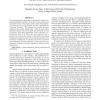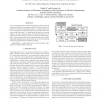114
click to vote
ICIP
2010
IEEE
14 years 11 months ago
2010
IEEE
Semi-automated object segmentation is an important step in the cinema post-production workflow. We propose a dense motion based segmentation process that employs sparse feature ba...
109
click to vote
ICIP
2010
IEEE
14 years 11 months ago
2010
IEEE
In this paper, we present a method to speed up video encoding of GPU rendered 3D scenes, which is particularly suited for the efficient and low-delay encoding of 3D game output as...
100
click to vote
ICIP
2010
IEEE
14 years 11 months ago
2010
IEEE
Because digital images can be modified with relative ease, considerable effort has been spent developing image forensic algorithms capable of tracing an image's processing hi...
82
Voted
ICIP
2010
IEEE
14 years 11 months ago
2010
IEEE
We propose a novel algorithm for denoising Poisson-corrupted images, that performs a signal-adaptive thresholding of the undecimated Haar wavelet coefficients. A Poisson's un...
ICIP
2010
IEEE
14 years 11 months ago
2010
IEEE
Delivery of 3D immersive entertainment to the home remains a highly challenging problem due to the large amount of data involved, and the need to support a wide variety of differe...
105
Voted
ICIP
2010
IEEE
14 years 11 months ago
2010
IEEE
In this paper, we propose a new 3D framework to identify and segment VBs and TBs in clinical computed tomography (CT) images without any user intervention. The Matched filter is e...
123
click to vote
ICIP
2010
IEEE
14 years 11 months ago
2010
IEEE
A new image segmentation method is proposed to combine the edge information with the feature-space method, K-Means clustering. A procedure called seam processing, which is computa...
107
click to vote
ICIP
2010
IEEE
14 years 11 months ago
2010
IEEE
We propose a new method to unmix hyperspectral images. Our method exploits the structure of the material abundance maps by assuming that in some regions of the spatial dimension, ...
100
Voted
ICIP
2010
IEEE
14 years 11 months ago
2010
IEEE
We develop a new passive image formation method capable of exploiting information about multiple scattering in the environment using measurements from a sparse array of receivers ...
102
click to vote
ICIP
2010
IEEE
14 years 11 months ago
2010
IEEE
Blotches are very common, localized, and non persistent impairments in digitized film archive. Many methods have been proposed so far for detecting them and restoring the underlyi...



